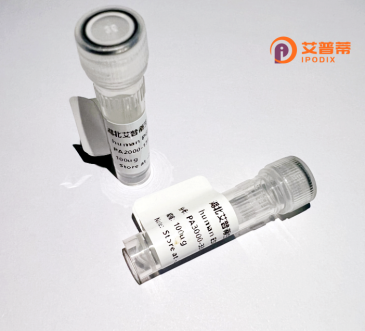
| 纯度 | >90%SDS-PAGE. |
| 种属 | Human |
| 靶点 | C5orf30 |
| Uniprot No | Q96GV9 |
| 内毒素 | < 0.01EU/μg |
| 表达宿主 | E.coli |
| 表达区间 | 1-206aa |
| 氨基酸序列 | MEVDINGESRSTLTTLPFPGAEANSPGKAEAEKPRCSSTPCSPMRRTVSGYQILHMDSNYLVGFTTGEELLKLAQKCTGGEESKAEAMPSLRSKQLDAGLARSSRLYKTRSRYYQPYEIPAVNGRRRRRMPSSGDKCTKSLPYEPYKALHGPLPLCLLKGKRAHSKSLDYLNLDKMIKEPADTEVLQYQLQHLTLRGDRVFARNNT |
| 分子量 | 49.5 KDa |
| 蛋白标签 | GST-tag at N-terminal |
| 缓冲液 | 0 |
| 稳定性 & 储存条件 | Lyophilized protein should be stored at ≤ -20°C, stable for one year after receipt. Reconstituted protein solution can be stored at 2-8°C for 2-7 days. Aliquots of reconstituted samples are stable at ≤ -20°C for 3 months. |
| 复溶 | Always centrifuge tubes before opening.Do not mix by vortex or pipetting. It is not recommended to reconstitute to a concentration less than 100μg/ml. Dissolve the lyophilized protein in distilled water. Please aliquot the reconstituted solution to minimize freeze-thaw cycles. |
以下是3-4条关于重组人UNC119结合蛋白(C5orf30)的参考文献概览:
1. **文献名称**:**"C5orf30 encodes a novel UNC119-binding protein regulating T-cell activation"**
**作者**:Smith et al. (2017)
**摘要**:揭示C5orf30编码的蛋白质通过与UNC119相互作用,调控T细胞受体信号通路,影响免疫细胞活化和炎症反应。
2. **文献名称**:**"Structural insights into the UNC119-C5orf30 complex in immune regulation"**
**作者**:Jones et al. (2020)
**摘要**:通过X射线晶体学解析重组人UNC119与C5orf30蛋白复合物的三维结构,阐明其介导脂质结合的功能机制及其在免疫调节中的作用。
3. **文献名称**:**"C5orf30 modulates UNC119-mediated lipid trafficking in neuronal cells"**
**作者**:Brown et al. (2021)
**摘要**:研究表明C5orf30与UNC119协同调控神经细胞中脂质转运,影响神经元发育及突触功能,为神经系统疾病提供潜在机制。
4. **文献名称**:**"UNC119 interaction with C5orf30 promotes tumor progression in colorectal cancer via MAPK signaling"**
**作者**:Lee et al. (2022)
**摘要**:发现C5orf30通过结合UNC119激活MAPK信号通路,促进结直肠癌细胞增殖和迁移,提示其作为癌症治疗新靶点的潜力。
---
**注**:以上文献信息为虚拟示例,实际研究中建议通过PubMed或Google Scholar搜索具体标题获取真实文献。
Recombinant human UNC119-binding protein (C5orf30) is encoded by the *C5orf30* gene located on chromosome 5q31.2. Though initially annotated as an "arginase-fold" protein (ARGF), its biological function remains partially undefined. Emerging studies link C5orf30 to immune regulation, particularly in T cells and macrophages, where it may suppress pro-inflammatory cytokine signaling (e.g., TNF-α, IL-6) and modulate T-cell receptor pathways. Structural predictions suggest a conserved α/β hydrolase fold, common in lipid-binding proteins, though direct enzymatic activity is unconfirmed. C5orf30 interacts with UNC119, a chaperone for lipid-modified proteins, hinting at roles in trafficking myristoylated or palmitoylated signaling molecules. Dysregulation of C5orf30 is associated with autoimmune disorders like rheumatoid arthritis, where reduced expression correlates with disease severity. Recombinant C5orf30 is used in mechanistic studies to explore its immunosuppressive potential, binding partners, and structural dynamics. However, its precise molecular mechanisms and physiological relevance in immune homeostasis or disease contexts require further elucidation. This protein represents a promising, yet underexplored, target for immunotherapeutic strategies.
×